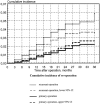Reoperation after recurrent groin hernia repair
- PMID: 11420492
- PMCID: PMC1421957
- DOI: 10.1097/00000658-200107000-00018
Reoperation after recurrent groin hernia repair
Abstract
Objective: To analyze reoperation rates for recurrent and primary groin hernia repair documented in the Swedish Hernia Register from 1996 to 1998, and to study variables associated with increased or decreased relative risks for reoperation after recurrent hernia.
Methods: Data were retrieved for all groin hernia repairs prospectively recorded in the Swedish Hernia register from 1996 to 1998. Actuarial analysis adjusted for patients' death was used for calculating the cumulative incidence of reoperation. Relative risk for reoperation was estimated using the Cox proportional hazards model.
Results: From 1996 to 1998, 17,985 groin hernia operations were recorded in the Swedish Hernia Register, 15% for recurrent hernia and 85% for primary hernia. At 24 months the risk for having had a reoperation was 4.6% after recurrent hernia repair and 1.7% after primary hernia repair. The relative risk for reoperation was significantly lower for laparoscopic methods and for anterior tension-free repair than for other techniques. Postoperative complications and direct hernia were associated with an increased relative risk for reoperation. Day-case surgery and local infiltration anesthesia were used less frequently for recurrent hernia than for primary hernia.
Conclusions: Recurrent groin hernia still constitutes a significant quantitative problem for the surgical community. This study supports the use of mesh by laparoscopy or anterior tension-free repair for recurrent hernia operations.
Figures
References
-
- Gunnarsson U, Heuman R. Recurrence of hernia from the patient perspective [abstract]. Hernia 1999; 3: (suppl 2) S68.
-
- Nilsson E, Haapaniemi S, Gruber G, et al. Methods of repair and risk for reoperation in Swedish hernia surgery 1992–1996. Br J Surg 1998; 85: 1686–1691. - PubMed
-
- Nilsson E, Haapaniemi S. Assessing the quality of hernia repair. In: Fitzgibbons R Jr, Greenburg AG, eds. Hernia. Philadelphia: Lippincott Williams and Wilkins, 2001.
-
- Lichtenstein IL, Shulman AG, Amid PK, et al. The tension-free hernioplasty. Am J Surg 1989; 157: 188–193. - PubMed
Publication types
MeSH terms
LinkOut - more resources
Full Text Sources


